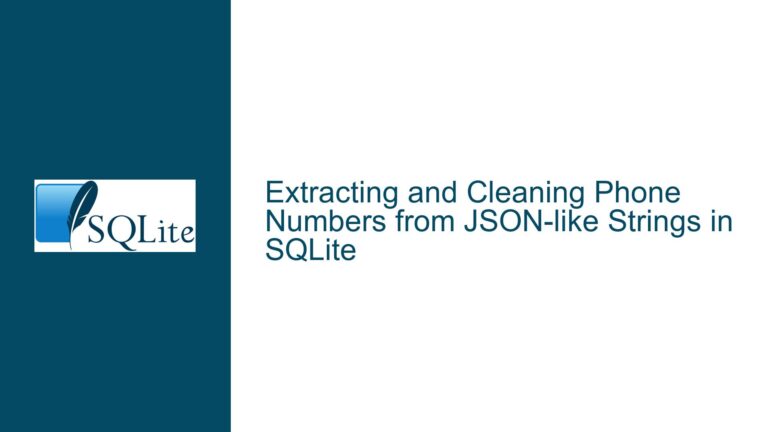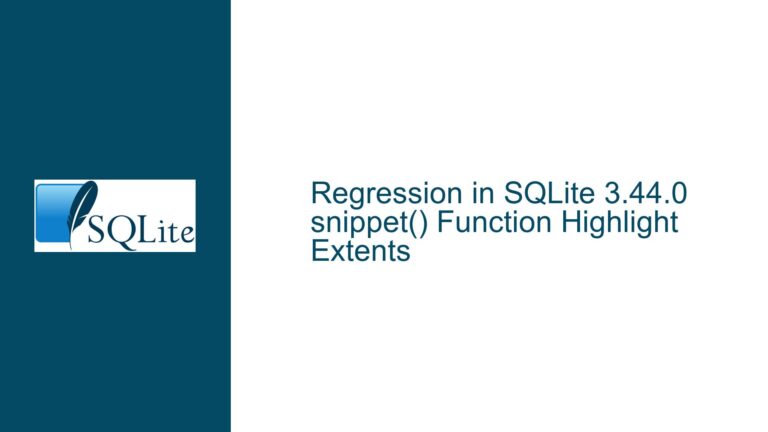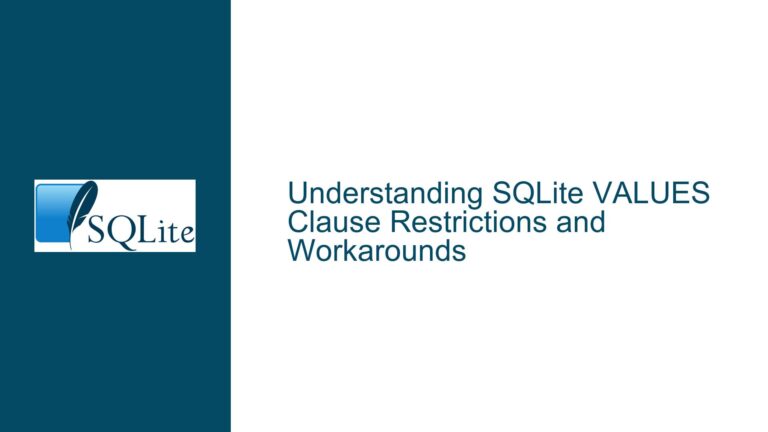Handling Epoch Timestamps and String Manipulation in SQLite
Issue Overview: Extracting and Filtering Epoch Timestamps Embedded in Text Columns
The core issue revolves around extracting Unix epoch timestamps (also referred to as Unix timestamps) from a text column in an SQLite database and using these timestamps for filtering or updating rows. The text column contains a Unix timestamp at the beginning, followed by additional text. The challenge lies in efficiently isolating the timestamp portion, converting it into a usable format, and performing operations such as filtering or updating based on this extracted value.
The initial approach attempted to use the LIKE operator with strftime to match the timestamp within the text. However, this method is problematic due to SQLite’s handling of string literals and the inefficiency of fuzzy string matching. The discussion then explores alternative methods, including the use of SQLite’s date/time functions, regular expressions, and string manipulation functions to achieve the desired outcome.
Possible Causes: Misuse of String Comparison and Lack of Data Normalization
The primary cause of the issue is the misuse of string comparison operators (LIKE) for a task that requires precise date/time handling. The LIKE operator is designed for pattern matching within strings, but it is not well-suited for extracting and comparing date/time values, especially when these values are embedded within a larger text field. This approach can lead to inefficiencies and inaccuracies, particularly when dealing with large datasets.
Another contributing factor is the lack of data normalization. Storing timestamps within a text column, rather than in a dedicated date/time column, complicates querying and indexing. Proper normalization would involve extracting the timestamp into a separate column during data ingestion, allowing for more efficient and straightforward queries.
Additionally, the initial attempt to use strftime with LIKE highlights a misunderstanding of SQLite’s string literal syntax. SQLite requires single quotes for string literals, and double quotes are reserved for identifiers. This syntax error would prevent the query from executing correctly.
Troubleshooting Steps, Solutions & Fixes: Efficient Extraction and Querying of Embedded Timestamps
To address the issue, we need to focus on three main areas: extracting the timestamp from the text column, converting it into a usable format, and performing efficient queries or updates based on the extracted timestamp.
1. Extracting the Timestamp from the Text Column
The first step is to isolate the timestamp portion from the text column. Given that the timestamp is always at the beginning of the text and follows a consistent format (e.g., YYYY-MM-DD), we can use SQLite’s string manipulation functions to extract it.
One effective method is to use the substr function to extract the first 10 characters of the text column, which corresponds to the YYYY-MM-DD format:
SELECT substr(text, 1, 10) AS timestamp FROM posts;
This query will return the first 10 characters of the text column as the timestamp. If the timestamp format is different (e.g., includes time components), adjust the length parameter accordingly.
2. Converting the Extracted Timestamp into a Usable Format
Once the timestamp is extracted, it needs to be converted into a format that can be used for comparison or arithmetic operations. SQLite provides several date/time functions that can assist with this conversion.
If the timestamp is in the YYYY-MM-DD format, we can use the strftime function to convert it into a Unix epoch timestamp (seconds since 1970-01-01):
SELECT strftime('%s', substr(text, 1, 10)) AS epoch FROM posts;
This query converts the extracted YYYY-MM-DD timestamp into a Unix epoch timestamp. If the timestamp includes time components (e.g., YYYY-MM-DD HH:MM:SS), ensure that the substr function captures the entire timestamp before conversion.
3. Filtering or Updating Rows Based on the Extracted Timestamp
With the timestamp extracted and converted, we can now perform filtering or updating operations. For example, to filter rows where the timestamp falls within a specific range, we can use the BETWEEN operator:
SELECT id FROM posts
WHERE strftime('%s', substr(text, 1, 10)) BETWEEN :start_epoch AND :end_epoch;
In this query, :start_epoch and :end_epoch are placeholders for the start and end of the desired range, respectively. Replace these placeholders with actual Unix epoch values.
For updating rows, such as removing the timestamp from the text column, we can use the substr function to isolate the remaining text and update the column accordingly:
UPDATE posts
SET text = substr(text, 11)
WHERE strftime('%s', substr(text, 1, 10)) IS NOT NULL;
This query updates the text column by removing the first 10 characters (the timestamp) for rows where the extracted timestamp is valid. The strftime function returns NULL for invalid date/time strings, so the IS NOT NULL condition ensures that only rows with valid timestamps are updated.
4. Alternative Approaches: Regular Expressions and String Functions
While the above methods are effective, alternative approaches using regular expressions or string functions can also be employed, depending on the specific requirements and constraints.
For example, if the timestamp is always at the beginning of the text and consists solely of digits, we can use the ltrim function to check for the presence of non-digit characters:
SELECT id FROM posts
WHERE ltrim(text, '0123456789') != text;
This query selects rows where the text column starts with one or more digits, indicating the presence of a timestamp. The ltrim function removes leading digits, and the comparison ensures that the original text starts with digits.
Alternatively, if the timestamp is always in a specific format (e.g., YYYY-MM-DD), we can use the instr function to check for the presence of the format:
SELECT id FROM posts
WHERE instr(substr(text, 1, 10), '-') = 5 AND instr(substr(text, 6, 10), '-') = 8;
This query checks that the first 10 characters of the text column contain hyphens at the 5th and 8th positions, which is consistent with the YYYY-MM-DD format.
5. Optimizing Performance with Indexes and Preprocessing
To improve query performance, especially when dealing with large datasets, consider preprocessing the data to extract the timestamp into a separate column and indexing this column. This approach reduces the need for on-the-fly string manipulation and allows for more efficient querying.
For example, during data ingestion, extract the timestamp and store it in a dedicated column:
ALTER TABLE posts ADD COLUMN timestamp INTEGER;
UPDATE posts
SET timestamp = strftime('%s', substr(text, 1, 10))
WHERE strftime('%s', substr(text, 1, 10)) IS NOT NULL;
This query adds a timestamp column to the posts table and populates it with the Unix epoch timestamp extracted from the text column. Once the timestamp is stored in a dedicated column, queries can be optimized using indexes:
CREATE INDEX idx_posts_timestamp ON posts(timestamp);
With the timestamp column indexed, queries that filter or sort based on the timestamp will perform significantly faster.
6. Handling Edge Cases and Invalid Data
When working with embedded timestamps, it’s important to handle edge cases and invalid data gracefully. For example, if the text column contains rows without a valid timestamp, ensure that these rows are excluded from queries or updates.
One approach is to use the strftime function’s behavior of returning NULL for invalid date/time strings:
SELECT id FROM posts
WHERE strftime('%s', substr(text, 1, 10)) IS NOT NULL;
This query selects only rows where the extracted timestamp is valid. Similarly, when updating the text column to remove the timestamp, ensure that only rows with valid timestamps are updated:
UPDATE posts
SET text = substr(text, 11)
WHERE strftime('%s', substr(text, 1, 10)) IS NOT NULL;
By incorporating these checks, you can avoid errors and ensure that only valid data is processed.
7. Leveraging SQLite’s Date/Time Functions for Advanced Queries
SQLite’s date/time functions offer powerful capabilities for working with timestamps. For example, the julianday function can be used to calculate the difference between two dates in Julian days, which can be useful for range queries:
SELECT id FROM posts
WHERE abs(julianday(substr(text, 1, 10)) - julianday(:target_date)) < 1;
This query selects rows where the extracted timestamp is within one day of the target date. The julianday function converts the timestamp into a Julian day number, allowing for precise date arithmetic.
Similarly, the unixepoch function can be used to convert a date/time string directly into a Unix epoch timestamp:
SELECT id FROM posts
WHERE unixepoch(substr(text, 1, 10)) BETWEEN :start_epoch AND :end_epoch;
This query selects rows where the extracted timestamp falls within the specified Unix epoch range. The unixepoch function simplifies the conversion process, making the query more readable and efficient.
8. Best Practices for Schema Design and Data Ingestion
To avoid similar issues in the future, consider adopting best practices for schema design and data ingestion. When designing a schema, ensure that each column has a single, well-defined purpose. Avoid embedding multiple pieces of information (e.g., timestamps and text) within a single column.
During data ingestion, preprocess the data to extract and normalize relevant information. For example, if the incoming data contains a timestamp followed by text, extract the timestamp into a dedicated column before inserting the data into the database. This approach simplifies querying and indexing, leading to better performance and maintainability.
Conclusion
Handling embedded timestamps in SQLite requires a combination of string manipulation, date/time functions, and careful schema design. By extracting the timestamp into a dedicated column, converting it into a usable format, and leveraging SQLite’s powerful date/time functions, you can perform efficient and accurate queries and updates. Additionally, adopting best practices for schema design and data ingestion can help prevent similar issues in the future, ensuring that your database remains performant and maintainable.






